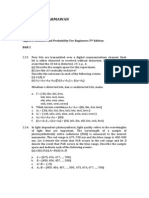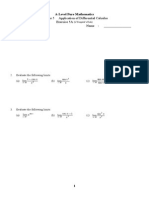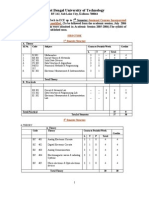RV and Distributions Examples
RV and Distributions Examples
Uploaded by
Shahrul AmirulCopyright:
Available Formats
RV and Distributions Examples
RV and Distributions Examples
Uploaded by
Shahrul AmirulCopyright
Available Formats
Share this document
Did you find this document useful?
Is this content inappropriate?
Copyright:
Available Formats
RV and Distributions Examples
RV and Distributions Examples
Uploaded by
Shahrul AmirulCopyright:
Available Formats
Random Variables and Distributions Examples
Example 1. Consider the experiment of tossing a coin twice. (a) (b) List the experimental outcomes. Define a random variable that represents the number of heads occurring on the two tosses. (c) Show what value the random variable would assume for each of the experimental outcomes. (d) Is this random variable discrete or continuous?
Example 2. Consider the experiment of a worker assembling a product. (a) Define a random variable that represents the time in minutes required to assemble the product. (b) (c) What values may the random variable assume? Is the random variable discrete or continuous?
Example 3. The probability distribution for the random variable x follows. x f(x) (a) (b) (c) (d) 20 0.20 25 0.15 30 0.25 35 0.40
Is this probability distribution valid? Explain. What is the probability that x = 30? [0.25] What is the probability that x less than or equal to 25? [0.35] What is the probability that x is greater than 30? [0.40]
Example 4. The following data were collected by counting the number of operating rooms in use at a hospital over a 20-day period: On three of the days only one operating room was used, on five of the days two were used, on eight of the days three were used, and on four days all four of the hospitals operating rooms were used. (a) Use the relative frequency approach to construct a probability distribution for the number of operating rooms in use on any given day. (b) (c) Draw a graph of the probability distribution. Show that your probability distribution satisfies the required conditions for a valid discrete probability distribution.
Random Variables and Distributions Examples
Example 5. The following table provides a probability distribution for the random variable x. x f(x) Compute (a) (b) (c) the expected value of x, E(x). [5.2] the variance of x, Var(x). [4.56] the standard deviation of x, Std(x). [2.14] 2 0.20 4 0.30 7 0.40 8 0.10
Example 6. A psychologist determined that the number of sessions required to obtain the trust of a new patients is either 1, 2, or 3. Let x be a random variable indicating the number of sessions required to gain the patients trust. The following probability function has been proposed.
f ( x) = x , for x = 1, 2, or 3. 6
(a) (b)
Is this probability function valid? Explain. What is the probability that it takes exactly 2 sessions to gain the patients trust? [1/3]
(c)
What is the probability that it takes at least 2 sessions to gain the patients trust? [5/6]
(d)
Compute the expected value of x, the variance of x, and the standard deviation of x. [2.333; 0.55556; 0.7454]
Example 7. The following table is a partial probability distribution for a companys projected profits (x = profit in $1000s) for the first year of operation (the negative value denotes a loss). x f(x) (a) (b) (c) (d) (e) 100 0.10 0 0.20 50 0.30 100 0.25 150 0.10 200
What is the proper value for f(200)? [0.05] What is the probability that the company will be profitable? [0.70] What is the probability that the company will make at least $100 000? [0.40] What is the expected profit? [55] What is the variance of the profit? [5 475]
Random Variables and Distributions Examples
Example 8. The random variable x is known to be uniformly distributed between 1.0 and 1.5. (a) (b) (c) (d) Show the graph of the probability density function. Compute P(x = 1.25). [0] Compute P(1.0 x 1.25). [0.50] Compute P(1.20 < x < 1.5). [0.60]
Example 9. The probability density of the continuous random variable x is given by
1 f ( x) = , 2 < x < 7 5
(a)
Draw its graph and verify that the total under the curve (above the x-axis) is equal to 1.
(b)
Find P(3 < x < 5). [2/5]
Example 10. A university provides bus service to students while they are on campus. A bus arrives at the University Library and the Student Residence stop every 30 minutes between 6 A.M. and 11 P.M. during weekdays. Students arrive at the bus stop at random times. The time that a student waits is uniformly distributed from 0 to 30 minutes. (a) (b) (c) (d) (e) (f) Draw a graph of this distribution. Show that the area of this uniform distribution is 1.00. What is the mean waiting time? [15] What is the standard deviation of the waiting times? [8.66] What is the probability a student will wait more than 25 minutes? [1/6] What is the probability a student will wait between 10 and 20 minutes? [1/3]
Example 11. Certain coded measurements of the pitch diameter of threads of a fitting have the probability density f ( x) =
4 , 0 < x < 1. (1 + x 2 )
Find the mean and the variance of this random variable. [0.4413; 0.0785]
Random Variables and Distributions Examples
Example 12. For each of the following, determine whether the given values can serve as the values of a probability distribution of a random variable with the range x = 1, 2, 3, and 4: (a) (b) f(1) = 0.25, f(2) = 0.75; f(3) = 0.25, and f(4) = -0.25; f(1) = 0.15, f(2) = 0.27; f(3) = 0.29, and f(4) = 0.29.
Example 13. For each of the following, determine c so that the function can serve as the probability distribution of a random variable with the given range: (a) (b) f(x) = cx, for x = 1, 2, 3, 4, 5; [1/15] f(x) = c(1/4)x, for x = 1, 2, 3, [3]
Example 14. For each of the following, determine whether the given values can serve as the values of a distribution function of a random variable with the range x = 1, 2, 3, and 4: (a) (b) F(1) = 0.3, F(2) = 0.5, F(3) = 0.8, and F(4) = 1.2; F(1) = 0.5, F(2) = 0.4, F(3) = 0.7, and F(4) = 1.0.
Example 15. Find the distribution function of the random variable which has the probability distribution
f ( x) = x , for x = 1, 2, 3, 4, 5 15
Example 16. If X has the distribution function x <1 0, 1 / 3, 1 x < 4 F ( x ) = 1 / 2, 4 x < 6 5 / 6, 6 x < 10 1, x 10 Find (a) (b) (c) P(2 < X 6); [1/2] P(X = 4); [1/6] the probability distribution of X.
Random Variables and Distributions Examples
Example 17. The probability density function (p.d.f) of the random variable X is given by c , 0< x<4 f ( x) = x 0, elsewhere Find (a) (b) (c) the value of c; [1/4] P(X < 1/4) and P(X > 1); [1/4; 1/2] the distribution function of the random variable X and use it to determine the probabilities in part (b).
Example 18. The density function of the random variable X is given by 6 x (1 x ), 0 < x < 1 f ( x) = 0, elsewhere Find (a) (b) P(X < 1/4) and P(X > 1/2); [5/32; 1/2] the distribution function of the random variable X and use it to determine the probabilities in part (a).
Example 19. The distribution function of the random variable X is given by
x < 1 0, 1 F ( x ) = 2 ( x + 1), 1 x < 1 1, x 1
Find (a) (b) P(1/2 < X < 1/2) and P(2 < X < 3); [1/2; 0] the probability density of the random variable X and use it to determine the probabilities in part (a).
Example 20. The distribution function of the random variable X is given by
x < 2 0, 1 F ( x ) = 4 ( x + 2), 2 x < 2 1, x2
Find P(X = 2), P(X = 2), P(2 < X < 1), and P(0 X 2). [0; 0; 3/4; 1/2]
You might also like
- STAT0007 Course NotesDocument93 pagesSTAT0007 Course NotesMusa AsadNo ratings yet
- Chapter 3Document26 pagesChapter 3Renukadevi Rpt33% (3)
- 3 Discrete Random VariablesDocument8 pages3 Discrete Random VariablesHanzlah NaseerNo ratings yet
- Discrete MathDocument25 pagesDiscrete MathKhairah A KarimNo ratings yet
- 1189165765saaexercises and Answers BankDocument7 pages1189165765saaexercises and Answers BankKudakwashe RuzvidzoNo ratings yet
- Sampling and Sampling DistributionDocument47 pagesSampling and Sampling Distributionkaszulu1No ratings yet
- (EP2091) Tugas ProbstatDocument8 pages(EP2091) Tugas ProbstatReza DarmawanNo ratings yet
- Applications of Differential Calculus ExerciseDocument17 pagesApplications of Differential Calculus ExerciseIsmail HashimNo ratings yet
- Discrete Probability DistributionDocument21 pagesDiscrete Probability DistributionXindy LimNo ratings yet
- MTE 11-English2021Document5 pagesMTE 11-English2021riyaasharmaa7557No ratings yet
- HW4Document7 pagesHW4Pallavi RaiturkarNo ratings yet
- 3 Discrete Random Variables and Probability DistributionsDocument26 pages3 Discrete Random Variables and Probability DistributionsRenukadevi RptNo ratings yet
- Mathematical ExpectationDocument38 pagesMathematical ExpectationraachelongNo ratings yet
- ACTU 475 Mid1 S1 1443 - Corr - 0Document7 pagesACTU 475 Mid1 S1 1443 - Corr - 0masrawy eduNo ratings yet
- 5th Unit Random Variate GenerationDocument20 pages5th Unit Random Variate Generationchandrashekar BNo ratings yet
- Discrete Probability DistributionDocument21 pagesDiscrete Probability DistributionJolyn LeeNo ratings yet
- 1 of Chapter 3 Random Variables and Discrete Probability DistributionsDocument16 pages1 of Chapter 3 Random Variables and Discrete Probability DistributionsDmddldldldlNo ratings yet
- Random VariablesDocument68 pagesRandom VariablesSree Lakshmi DeeviNo ratings yet
- Chapter 4Document21 pagesChapter 4Anonymous szIAUJ2rQ080% (5)
- 2.1 Random Variables 2.1.1 Definition: PX PX XDocument13 pages2.1 Random Variables 2.1.1 Definition: PX PX XMichael Hsiao100% (1)
- 04 ES Random VariablesDocument17 pages04 ES Random VariablesMuhammad AbdullahNo ratings yet
- MTE 01 EngDocument5 pagesMTE 01 EngdesperadomarNo ratings yet
- Chapter 5: Sampling Distributions: Solve The ProblemDocument4 pagesChapter 5: Sampling Distributions: Solve The ProblemEunice WongNo ratings yet
- Random VariableDocument13 pagesRandom VariableRenuga SubramaniamNo ratings yet
- Statistics - Discrete Probability DistributionsDocument36 pagesStatistics - Discrete Probability DistributionsDr Rushen SinghNo ratings yet
- Probability and Statistics With R For Engineers and Scientists 1st Edition Michael Akritas Solutions ManualDocument18 pagesProbability and Statistics With R For Engineers and Scientists 1st Edition Michael Akritas Solutions Manuala3880087880% (1)
- Discrete Random Variables and Probability DistributionsDocument23 pagesDiscrete Random Variables and Probability DistributionsSheikh MisbahNo ratings yet
- Sheet 4Document3 pagesSheet 4ahmedmohamedn92No ratings yet
- 3random Variable - Joint PDF Notes PDFDocument33 pages3random Variable - Joint PDF Notes PDFAndrew TanNo ratings yet
- QT I (Probability Dist)Document22 pagesQT I (Probability Dist)aman singhNo ratings yet
- Chapter 3 - Clean Random Variables and Probability Distributions NotesDocument17 pagesChapter 3 - Clean Random Variables and Probability Distributions NoteszazoNo ratings yet
- MSC Numerical 2007Document6 pagesMSC Numerical 2007Matthew FunnellNo ratings yet
- Screenshot 2024-02-07 at 3.23.37 PMDocument2 pagesScreenshot 2024-02-07 at 3.23.37 PMreddysaicharanya123No ratings yet
- Unit 4. Probability DistributionsDocument18 pagesUnit 4. Probability DistributionszinfadelsNo ratings yet
- Chapter 3Document6 pagesChapter 3Frendick LegaspiNo ratings yet
- Chapter 6 Alford PDFDocument179 pagesChapter 6 Alford PDFrovelyn giltendezNo ratings yet
- 05 ES Random Variables and Their Probability DistributionsDocument30 pages05 ES Random Variables and Their Probability DistributionsM. Ahmad100% (2)
- Indian Institute of Technology, KharagpurDocument2 pagesIndian Institute of Technology, KharagpurSri Chandra DudduNo ratings yet
- Question 1 (4 Points) : © B.M. Wouters (Uva), 2020Document4 pagesQuestion 1 (4 Points) : © B.M. Wouters (Uva), 2020Danish ElahiNo ratings yet
- Engineering Statistics - 4Document43 pagesEngineering Statistics - 4Kader KARAAĞAÇNo ratings yet
- P2 SMK Ampuan Durah SerembanDocument5 pagesP2 SMK Ampuan Durah SerembanmasyatiNo ratings yet
- Notes 32Document4 pagesNotes 3224jtrujilloNo ratings yet
- Extreme Event Statistics Coursework 1 2013-14Document4 pagesExtreme Event Statistics Coursework 1 2013-14yous123No ratings yet
- 37 - Ex 8C Discrete Random VariablesDocument16 pages37 - Ex 8C Discrete Random VariablesRalph Rezin MooreNo ratings yet
- Probability Distributions and Statistics and 10. Probability and Calculus (Combined Chapters)Document7 pagesProbability Distributions and Statistics and 10. Probability and Calculus (Combined Chapters)davogezuNo ratings yet
- III-Discrete DistributionsDocument46 pagesIII-Discrete DistributionsΙσηνα ΑνησιNo ratings yet
- Aero 630: Introduction To Random Dynamical SystemsDocument1 pageAero 630: Introduction To Random Dynamical SystemsAnonymous 3Jg6ZUlTGNo ratings yet
- A) An Inference Made About The Population Based On The SampleDocument11 pagesA) An Inference Made About The Population Based On The SamplePeArL PiNkNo ratings yet
- ECE 6337 HW 1-7 and Soln 1-7Document19 pagesECE 6337 HW 1-7 and Soln 1-7Sose ManukNo ratings yet
- Assigment Prob. N Stat.Document34 pagesAssigment Prob. N Stat.Syuaib Supani100% (1)
- Tutorial Week4Document3 pagesTutorial Week4Aditya GajbhiyeNo ratings yet
- Probability and Statistical Course.: Instructor: DR - Ing. Sergio A. Abreo CDocument45 pagesProbability and Statistical Course.: Instructor: DR - Ing. Sergio A. Abreo CJuan Diego MuñozNo ratings yet
- Mso201 3 2014Document3 pagesMso201 3 2014Sai SaurabNo ratings yet
- Solves Problems-WPS OfficeDocument22 pagesSolves Problems-WPS OfficeRitchell Mae MalolotNo ratings yet
- Assignment 2 - Engineering Statistics PDFDocument5 pagesAssignment 2 - Engineering Statistics PDFNamra FatimaNo ratings yet
- Tutprac 1Document8 pagesTutprac 1Pham Truong Thinh LeNo ratings yet
- Estimating PDF'S, Means, Variances: 1 Exp 1: Estimated PDF/CDF Plots From DataDocument12 pagesEstimating PDF'S, Means, Variances: 1 Exp 1: Estimated PDF/CDF Plots From DataShaimaa El SayedNo ratings yet
- 3 ES Discrete Random VariablesDocument8 pages3 ES Discrete Random VariablesM WaleedNo ratings yet
- Homework 4: STAT 110 B, Probability & Statistics For Engineers II UCLA Statistics, Spring 2003Document2 pagesHomework 4: STAT 110 B, Probability & Statistics For Engineers II UCLA Statistics, Spring 2003rohitrgt4uNo ratings yet
- Log-Linear Models, Extensions, and ApplicationsFrom EverandLog-Linear Models, Extensions, and ApplicationsAleksandr AravkinNo ratings yet
- Implementation of Strategic Management Practices in The Malaysian Construction IndustryDocument15 pagesImplementation of Strategic Management Practices in The Malaysian Construction IndustryShahrul AmirulNo ratings yet
- Implementation of Strategic Management Practices in The Malaysian Construction IndustryDocument15 pagesImplementation of Strategic Management Practices in The Malaysian Construction IndustryShahrul AmirulNo ratings yet
- R/etl Ol4nR NO:: Management Universiti MalaysiaDocument1 pageR/etl Ol4nR NO:: Management Universiti MalaysiaShahrul AmirulNo ratings yet
- Diddy's Pizza - Menu 'Ala CarteDocument2 pagesDiddy's Pizza - Menu 'Ala CarteShahrul AmirulNo ratings yet
- Askum N Very Evening To AllDocument1 pageAskum N Very Evening To AllShahrul AmirulNo ratings yet
- Information Theories Solutions Detail Trang 2Document19 pagesInformation Theories Solutions Detail Trang 2ThuyNo ratings yet
- SEMESTER IIIsyDocument11 pagesSEMESTER IIIsyshivaniNo ratings yet
- Or Ques-Category 202303Document23 pagesOr Ques-Category 202303Eaint Lay HmoneNo ratings yet
- S1 Cheat SheetDocument9 pagesS1 Cheat SheetZig ZagNo ratings yet
- Maity2018 Chapter BasicConceptsOfProbabilityAndSDocument46 pagesMaity2018 Chapter BasicConceptsOfProbabilityAndSKhader Mohamed100% (1)
- Azzouz DeclarationDocument27 pagesAzzouz DeclarationAngelo FicheraNo ratings yet
- Crashing - StevensonDocument5 pagesCrashing - StevensonFrancisco GordilloNo ratings yet
- Assignment 1Document4 pagesAssignment 1Mohanad AlyNo ratings yet
- MSC Artificial Intll Ud 2024 25 (1) - OKDocument75 pagesMSC Artificial Intll Ud 2024 25 (1) - OKnirmala.deviNo ratings yet
- VaresDocument163 pagesVarestazakka ghiffarNo ratings yet
- Special Instructions / Useful Data: X X X I N PADocument17 pagesSpecial Instructions / Useful Data: X X X I N PAaishwarya asawaNo ratings yet
- Tutorial 2 (Common For All Branches ECE & CSE) : FX e XDocument2 pagesTutorial 2 (Common For All Branches ECE & CSE) : FX e Xritvik tanksalkarNo ratings yet
- Chapter 02 Test Bank - Version1Document38 pagesChapter 02 Test Bank - Version1lizarrdoNo ratings yet
- Engineering Data AnalysisDocument2 pagesEngineering Data AnalysisRenz MonedaNo ratings yet
- Reliability Distribution 1Document41 pagesReliability Distribution 1anil.amminaNo ratings yet
- Lecture 1Document38 pagesLecture 1Vishnu VenugopalNo ratings yet
- Accident ModellingDocument35 pagesAccident ModellingFireProtectionEngineerNo ratings yet
- Statistics PDFDocument28 pagesStatistics PDFaryadhruv128No ratings yet
- Group A:Brief Questions (10 X 2 Marks 20)Document2 pagesGroup A:Brief Questions (10 X 2 Marks 20)Dipendra GiriNo ratings yet
- Biostat ManualDocument97 pagesBiostat ManualTwaha R. Kabandika100% (1)
- BIOSTAT Random Variables & Probability DistributionDocument37 pagesBIOSTAT Random Variables & Probability DistributionAnonymous Xlpj86laNo ratings yet
- Normal CurveDocument80 pagesNormal CurvePrecious EspejoNo ratings yet
- Icap Syllabus 2015 PDFDocument80 pagesIcap Syllabus 2015 PDFwaleedrana786No ratings yet
- Electronics & Communication Engineering Syllabus Revised Upto 7th Semester 2007Document48 pagesElectronics & Communication Engineering Syllabus Revised Upto 7th Semester 2007Arnab Guha MallikNo ratings yet
- CQE Academy Equation Cheat Sheet - DDocument15 pagesCQE Academy Equation Cheat Sheet - DAmr AlShenawyNo ratings yet
- Mathematics - Statistics 2Document2 pagesMathematics - Statistics 2Zaman Ali RajaNo ratings yet
- Advanced Level StatisticsDocument10 pagesAdvanced Level StatisticsPAUL KOLERENo ratings yet
- EEN330 - Random Signals and Noise-Syllabus - Spring 22-23Document4 pagesEEN330 - Random Signals and Noise-Syllabus - Spring 22-23miss clairNo ratings yet




























































































